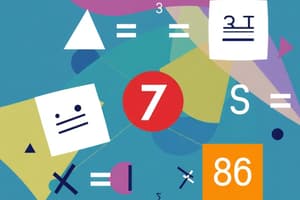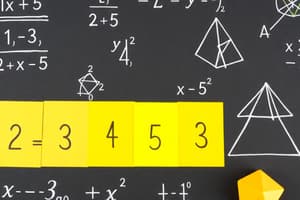Podcast
Questions and Answers
What is the correct order of operations when evaluating an expression?
What is the correct order of operations when evaluating an expression?
- Parentheses, Exponents, Multiplication and Division, Addition and Subtraction (correct)
- Addition, Subtraction, Multiplication, Division
- Multiplication, Division, Parentheses, Exponents
- Parentheses, Exponents, Addition, Subtraction
Which of the following concepts is used to solve for an unknown in linear equations?
Which of the following concepts is used to solve for an unknown in linear equations?
- Isolating variables (correct)
- Using the quadratic formula
- Factoring
- Completing the square
What is the formula to calculate the area of a triangle?
What is the formula to calculate the area of a triangle?
- Area = base + height
- Area = (base × height) / 2 (correct)
- Area = base × height
- Area = (base^2 × height) / 2
Which function in trigonometry relates to the ratio of the opposite side to the hypotenuse?
Which function in trigonometry relates to the ratio of the opposite side to the hypotenuse?
In statistics, which measure represents the middle value of a data set?
In statistics, which measure represents the middle value of a data set?
What does the greatest common divisor (GCD) of two numbers represent?
What does the greatest common divisor (GCD) of two numbers represent?
What type of growth does an exponential function represent?
What type of growth does an exponential function represent?
Which of the following is true about prime numbers?
Which of the following is true about prime numbers?
Which of the following statements is true about a logical contradiction?
Which of the following statements is true about a logical contradiction?
What does the midpoint formula calculate?
What does the midpoint formula calculate?
Flashcards are hidden until you start studying
Study Notes
Key Concepts in Mathematics
1. Arithmetic
- Basic operations: addition, subtraction, multiplication, division
- Properties: commutative, associative, distributive
- Order of operations: PEMDAS (Parentheses, Exponents, Multiplication and Division, Addition and Subtraction)
2. Algebra
- Variables and constants
- Expressions and equations
- Solving linear equations: isolating variables
- Quadratic equations: factoring, completing the square, quadratic formula
3. Geometry
- Basic shapes: triangles, squares, circles, polygons
- Properties: area, perimeter, volume
- Theorems: Pythagorean theorem, properties of angles
- Coordinate geometry: distance formula, midpoint formula, slope
4. Trigonometry
- Functions: sine, cosine, tangent
- Ratios: opposite, adjacent, hypotenuse
- Unit circle and radians
- Trigonometric identities: Pythagorean identities, angle addition formulas
5. Calculus
- Limits: understanding approaching values
- Differentiation: finding rates of change, slopes of curves
- Integration: calculating areas under curves, antiderivatives
- Fundamental theorem of calculus
6. Statistics
- Descriptive statistics: mean, median, mode, range
- Probability: basic concepts, independent and dependent events
- Distributions: normal distribution, binomial distribution
- Inferential statistics: hypothesis testing, confidence intervals
7. Functions
- Definition: relationship between inputs and outputs
- Types: linear, quadratic, polynomial, exponential, logarithmic
- Transformations: shifts, stretches, reflections
- Domain and range: identifying possible input and output values
8. Number Theory
- Prime numbers: definition and identification
- Divisibility rules
- Greatest common divisor (GCD) and least common multiple (LCM)
- Modular arithmetic
9. Mathematical Logic
- Statements: true, false, contradictions
- Logical connectors: AND, OR, NOT
- Quantifiers: universal and existential
- Proof techniques: direct proof, proof by contradiction, induction
10. Mathematical Reasoning
- Inductive reasoning: making generalizations based on observations
- Deductive reasoning: logical conclusions based on premises
- Problem-solving strategies: working backwards, simplifying the problem, considering special cases
Applications of Mathematics
- Real-world applications: finance, engineering, computer science, economics
- Importance in technology and data analysis
- Role in scientific research and problem-solving
Study Tips
- Practice regularly with a variety of problems.
- Focus on understanding concepts rather than memorization.
- Use visual aids: graphs, charts, and diagrams.
- Collaborate with peers to enhance learning.
Key Concepts in Mathematics
Arithmetic
- Fundamental operations include addition, subtraction, multiplication, and division.
- Essential properties:
- Commutative: Order doesn't affect the result (e.g., a + b = b + a).
- Associative: Grouping doesn't affect the result (e.g., (a + b) + c = a + (b + c)).
- Distributive: a(b + c) = ab + ac.
- Remember PEMDAS for order of operations: Parentheses, Exponents, Multiplication and Division, Addition and Subtraction.
Algebra
- Involves variables (symbols representing numbers) and constants (fixed values).
- Work with expressions (combinations of variables and constants) and equations (expressions set equal to each other).
- To solve linear equations, isolate the variable on one side.
- Quadratic equations can be solved by factoring, completing the square, or using the quadratic formula: x = (-b ± √(b²-4ac)) / 2a.
Geometry
- Basic shapes encompass triangles, squares, circles, and polygons.
- Key properties include calculating area, perimeter, and volume for different shapes.
- Important theorems like the Pythagorean theorem (a² + b² = c²) explain relationships in right triangles.
- Coordinate geometry involves formulas for distance (d = √((x₂ - x₁)² + (y₂ - y₁)²)), midpoint ((x₁+x₂)/2, (y₁+y₂)/2), and slope (m = (y₂ - y₁)/(x₂ - x₁)).
Trigonometry
- Core functions: sine (sin), cosine (cos), and tangent (tan).
- Ratios:
- Opposite side over hypotenuse for sine.
- Adjacent side over hypotenuse for cosine.
- Opposite side over adjacent side for tangent.
- The unit circle provides a way to understand angle measures in radians.
- Key identities include Pythagorean identities and angle addition formulas.
Calculus
- Limits help comprehend how functions behave as they approach a certain value.
- Differentiation is used to find rates of change or slopes of curves.
- Integration calculates areas under curves and determines antiderivatives.
- The Fundamental Theorem connects differentiation and integration.
Statistics
- Descriptive statistics summarize data using mean, median, mode, and range.
- Probability focuses on chance events and distinguishes between independent and dependent events.
- Common distributions include normal and binomial distributions.
- Inferential statistics involves hypothesis testing and constructing confidence intervals.
Functions
- Functions define a relationship between inputs (domain) and outputs (range).
- Varieties of functions include linear, quadratic, polynomial, exponential, and logarithmic.
- Transformations of functions include shifts (moving up/down/sideways), stretches, and reflections.
- Identifying the domain and range is crucial for understanding function behavior.
Number Theory
- Prime numbers are defined as natural numbers greater than 1 that have no positive divisors other than 1 and themselves.
- Divisibility rules determine whether one number can be divided by another without leaving a remainder.
- Key concepts include finding the Greatest Common Divisor (GCD) and Least Common Multiple (LCM).
- Modular arithmetic deals with integers and their equivalence classes under a modulus.
Mathematical Logic
- Statements can be classified as true, false, or contradictory.
- Logical connectors like AND, OR, NOT help form complex statements.
- Quantifiers include universal (for all) and existential (there exists).
- Proof techniques such as direct proof, proof by contradiction, and induction are foundational in mathematics.
Mathematical Reasoning
- Inductive reasoning makes generalizations from observations or specific cases.
- Deductive reasoning derives specific conclusions from general principles or premises.
- Problem-solving strategies involve approaches like working backwards, simplifying, or considering special cases.
Applications of Mathematics
- Mathematics is critical in fields such as finance, engineering, computer science, and economics.
- It plays a vital role in technology development and data analysis.
- Mathematics underpins scientific research and aids in problem-solving across many disciplines.
Study Tips
- Regularly practice a diverse range of problems to solidify understanding.
- Emphasize comprehension of concepts over rote memorization.
- Utilize visual aids like graphs, charts, and diagrams to illustrate mathematical ideas.
- Collaborate with peers to enhance collective learning and problem-solving capabilities.
Studying That Suits You
Use AI to generate personalized quizzes and flashcards to suit your learning preferences.




